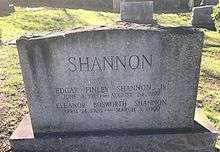Edgar F. Shannon, Jr.
| Edgar F. Shannon, Jr. | |
|---|---|
 | |
| Born | June 4, 1918 |
| Died |
August 24, 1997 (aged 79) Charlottesville, Virginia, United States |
| Resting place | University of Virginia Cemetery |
| Nationality | American |
| Alma mater |
Washington and Lee University Oxford University |
| Occupation | Educator |
| Known for | President of the University of Virginia |
| Term | 1959–1974 |
| Predecessor | Colgate Darden |
| Successor | Frank L. Hereford, Jr. |
Edgar F. Shannon, Jr. (June 4, 1918 – August 24, 1997) was a professor of English and president of the University of Virginia from 1959 to 1974.[1]
Biography
Shannon attended Washington and Lee University as an undergraduate and studied at Oxford University on a Rhodes scholarship. He was a veteran of the United States Navy, having served on the U.S.S. Quincy during World War II. He joined the faculty of the University of Virginia in 1956.[2]
Accomplishments during his administration include the establishment of the University of Virginia Press,[3] the establishment of the Center for Advanced Studies, and the creation of the Echols Scholar program. Shannon also oversaw significant increases in the value of the endowment; in 1962, a survey by the American Association of University Professors ranked the University first in the value of its endowment in proportion to its enrollment.[4]
One of Shannon's most significant legacies to the university was a building program that included the construction of Gilmer Hall, the Chemistry Building, Wilson Hall, the architecture building (Edmund S. Campbell Hall); the Fiske Kimball Library; the university's nuclear reactor; University Hall; the "new dormitories" (Alderman Road and Observatory houses), as well as additions to many university buildings and the purchase of the Old Ivy Inn and Birdwood.[5] The restoration of the Rotunda to its original state was funded and work was begun during Shannon's administration.

Shannon's presidency encompassed the 1960s, and he helped to lead the University's response to social trends of the time. As President, Shannon resigned his membership in the Farmington Country Club over its refusal to admit black members,[6] and worked to increase recruiting of black students and faculty.[7] He also initiated undergraduate coeducation over the protests of alumni.[8] He is perhaps most remembered for his response to growing student unrest over the Vietnam War, during which he sent a letter to President Nixon opposing the invasion of Cambodia.[9]
He is buried at the University of Virginia Cemetery.
Notes
References
- Dabney, Virginius. Mr. Jefferson's University: A History. Charlottesville: University of Virginia Press, 1981. ISBN 0-8139-0904-X.
- "Edgar Shannon, Ex-President of UVA, Dies". Virginia Pilot, August 25, 1997, p. B4.
- "E.F. Shannon Jr., 79, Dies; Forceful Chief of U.Va.", New York Times, August 26, 1997.